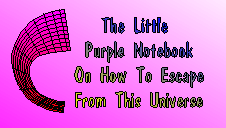
4220. Mystic Exercises
Many remarks in
this 'Little Purple Notebook' point to the difference between the 'rational
path' and the 'intuitive path'. As emphasized, Gotamo stated that only
the 'rational path' can be gone by _everybody_. The 'intuitive path' requires
special talents and
is inherently unsafe.
One could label the 'rational path' as 'processing' and the 'intuitive path' as 'meditation'.
The way things are practiced in Buddhist and New Age communities these days, however, has led to the situation that nowadays about every activity is being labeled 'meditation'.
Showing how the 'intuitive path' is being entered does not mean that the author would encourage it! It is here only to round off the picture.
'Real' meditation as in these exercises should NEVER EVER be done in a group. It should ONLY be done in complete solitude and within a safe environment. Some of the reasons for this rule are explained in another chapter of PNOHTEFTU. _ALL_ exercises that were presented by Gotamo, for example, are prefixed by this very important rule.
If this rule is broken, it may happen that the meditant is being touched while being in the state of samaadhi (even if it's just by the house cat), or, in the very worst case, the body is being moved.
There is NO known process to this date that can reliably repair such an incident, and allowing this to happen is an overt of magnitude (cp. also 'The Karma of a Teacher'!)
Now, after all these dire warnings, here is the 'traditional' way to enter 'mystic' states, the so-called kasi.naa exercises:
Step 1:
One selects a visible
object, for example: a colored disk, a clearly recognizable spot on the
ground, a pond or a lake in the distance, or a very small light source
such as the light
from another room shining through a keyhole or a gap in the roof during
daytime.)
Step 2:
One concentrates
on this visible object with undivided attention until one perceives an
image that can be likened to the moon. This image should be perceived with
open _and_ closed eyes and it is called the 'learnt image' (uggaha-nimitta.m).
Step 3:
If one continues
to concentrate on this image (which should stay even if one is going to
a different place), an image will appear that looks like a sparkling star
or like the moon when it comes out of the clouds. This is a color- and
formless 'inner image' (patibhaaga-nimmitta.m).
At this point the (mental) obstacles (niivaranaa) will disappear and the state that is 'bordering samaadhi' (upacaara samaadhi) is being entered.
Samaadhi itself can be induced by a simple trick but it can also occur inadvertently. This is a state in which the physical body functions, such as heart beat and breathing will come to a complete rest.
Nothing for the faint-hearted, obviously, and, again, this exercise is listed here only to give a glimpse of the 'intuitive path'.
Step 2 above also acts as a very effective way of achieving 'exteriozation' (a term that should be used with caution (cp. 'Int, Ext, and Perm'). Much faster, reliable, and cheaper than listening to 'hemisync' tapes, anyway. And at least there are some repairs of exteriozation problems (in lingo: 'out-int') available even though they are very unreliable at times (which puts quite a crimp on exercises like this).
It is conceivable that modern technology could provide some sort of biofeedback machine that would facilitate 'mystic contemplations' (jhaanaa). Entering the state above is a dramatic experience. Since there are no reports of the various phenomena that can occur during upacaara samaadhi (let alone samaadhi itself), it can be assumed that the existing gadgets do _not_ lead there (yet).
In any case, it is _much_ safer to stay on the 'rational path', the 'processing' side.